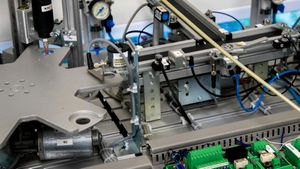The efficacy of oral lactoferrin treatment has emerged as a significant development for managing anemia resulting from chronic kidney disease (CKD) among pediatric patients. A recent randomized controlled trial conducted at Menoufia University Hospitals has demonstrated promising outcomes, comparing oral lactoferrin to the established intravenous iron dextran therapy.
This trial, which took place over several months, involved 60 children diagnosed with anemia related to CKD. Participants were randomly assigned to receive either 100 mg of oral lactoferrin daily or 50 mg of intravenous iron dextran administered three times weekly for three months. The results yielded encouraging insights, highlighting the safety and effectiveness of oral lactoferrin, which may provide hope to parents and caregivers grappling with the challenges of treating anemia.
Chronic kidney disease significantly impacts the quality of life for children, often leading to severe anemia due to factors including blood loss and reduced iron absorption. Conventional treatments typically involve injectable iron supplements, which may carry various side effects and cause discomfort. During the trial, researchers aimed to assess whether lactoferrin, known for its multifunctional benefits as an immune modulator and antibacterial protein, could serve as a viable oral alternative.
According to the authors of the article, "Lactoferrin is a reasonable oral alternative to injectable preparations with more patient compliance and good prognosis in treating anemia resulted from CKD." This statement encapsulates the essence of the findings, as lactoferrin not only improved hematological parameters—like hemoglobin and red blood cell counts—but did so without the adverse effects typically associated with intravenous treatments.
Throughout the study, both treatments were effective at managing anemia, with oral lactoferrin showcasing superior efficacy. Significant changes were observed within the lactoferrin group across various key parameters, including hemoglobin levels, red blood cell counts, and other relevant biomarkers. Meanwhile, intravenous iron dextran displayed effectiveness but was marked by side effects, illustrating the volatility often associated with injected therapies.
The significance of these findings extends beyond immediate treatment. Anemia can lead to reduced survival rates and compromised energy, growth, and academic performance among children with CKD. By shifting focus toward lactoferrin, healthcare providers may mitigate various complications related to iron administration and improve overall patient health outcomes.
According to the researchers, both drugs caused a highly significant decrease in IL-6 levels, referring to the inflammatory cytokine linked to hepcidin regulation. This relationship plays a pivotal role, as hepcidin affects iron absorption and is often elevated during CKD episodes. Effective management of IL-6 through lactoferrin treatment could offer enhanced iron bioavailability, which is favorable for children suffering from chronic anemia.
Between February 2023 and March 2024, researchers collected data from trial participants, documenting demographic details and treatment responses. Both groups underwent comprehensive assessments before and after the three-month treatment period, allowing for meaningful comparisons of the clinical outcomes. Notably, the study highlighted how lactoferrin's unique properties, including strong iron binding, may favor its rapid absorption and utilization within the body.
This research paves the way for future explorations of lactoferrin's potential applications within pediatric nephrology. Currently, IV iron treatments require close monitoring due to risks like hypersensitivity reactions and infectious complications. With oral lactoferrin, these issues could be effectively addressed, leading to more manageable, patient-friendly treatment protocols.
The study's conclusion indicates clearly: both oral lactoferrin and IV iron dextran can effectively treat anemia among CKD pediatric patients, but lactoferrin proves more advantageous—with fewer side effects and enhanced patient satisfaction. These new insights might spur changes to standard anemia interventions, ensuring children diagnosed with CKD experience improved treatment outcomes.
Overall, the promising results of this trial firmly suggest the feasibility of utilizing oral lactoferrin as both a standalone treatment or adjunct therapy for managing chronic anemia due to kidney disorders. Continued investigation and future trials could solidify its place on the front lines of pediatric nephrology.



